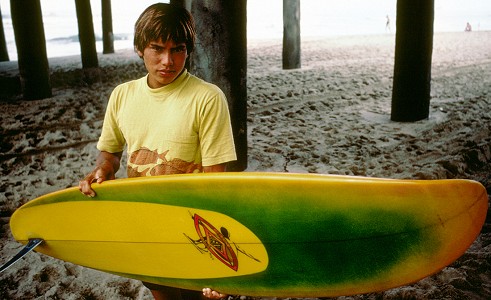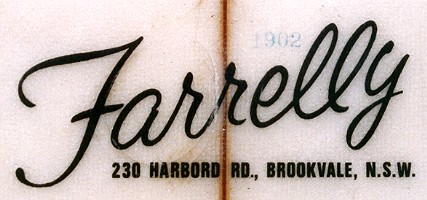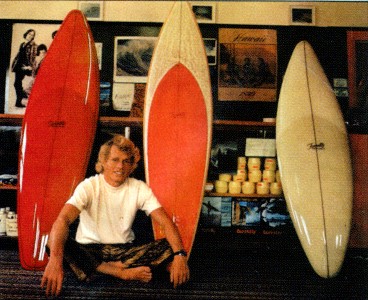 |
surfresearch.com.au
the catalogue #306 |
| home | catalogue | history | references | appendix |
|
|
|||||||||||||||||||||||||||||||||||||||||||||||||
 |
|||||||||||||||||||||||||||||||||||||||||||||||||
| MANUFACTURE
MANUFACTURER: Farrelly Surfboards, 230 Harboard Road Brookvale Sydney SHAPER: Unknown (possibly Warren Cornish) DESIGN: Side Slipper DESIGNER: Reno Abellira Australia : Midget Farrelly - Terry Fitzgerald |
|||||||||||||||||||||||||||||||||||||||||||||||||
| SPECIFICATIONS
CONSTRUCTION Foam blank with 1/8'' redwood stinger, Volan glass with blue tint, resin pinlines and decor, fin box. DIMENSIONS
Nose: rounded Tail: rounded Deck: S-deck, domed Bottom: flat , vee behind fin. Rails: 50/50 in nose and soft down rail from 1/3 rd back, harder in the tail. Rocker: distinct nose lift |
|||||||||||||||||||||||||||||||||||||||||||||||||
|
|||||||||||||||||||||||||||||||||||||||||||||||||
|
|||||||||||||||||||||||||||||||||||||||||||||||||
| NOTES
BOARD HISTORY Dimensions and photographs Sydney Surf Auction, Mona Vale Hotel, Sydney, 30 th October September 2004 Catalogue No. 9 : FARRELLY 6 ' 6'' "SLIPPER" DESIGN 1970's Blue with white pinlines, out there! No condition rating. Catalogue Notes by Mick Mock, PO Box 330 Manly NSW Australia 2095. Thanks to Mick Mock. MANUFACTURER
HISTORY DESIGN
HISTORY A compendium of (long board) manouvres , it includes... FIN
DROP-OUT STALL IMPORTANT
: Not to be confused with "slipping the board "
- a nose riding manouvre taht does not dis-engage the
fin. SIDE SLIPS can
be performed anywhere on the front half of the
board. Side
slipping became an recognised manourve in 1969, as
demontrated in John Severson's Pacific
Vibrations, 1970.
Inter-Island Surfboards, Hawaii.  Reno Abellira and Inter-Island Side Slipper with hyper-kicked nose, Huntington Pier, California, 1969. Photograph Art Brewer - Nat Young : History, Page 104 To initiate the side slip the fin had to be dis-engaged, so the design critically relied of using smaller and inter-changable fins. Fin boxes were virtually a required addition. This demand encouraged research into fin boxes and by 1972 the Bahne system became an industry standard. A flat
bottom with a down soft rail that reduced the
possiblility of catching edges was used to control the
side-slip and re-engage the fin A
hyperkicked nose reduced the chance of burying the
nose and helped in recovery. In Australia the down soft rail, with a release edge, was developed through the experiments of Gordon Merchant. (Find relevant articles) In Australia the design was taken up by Midget Farrelly (Farrelly Surfboards) and Terry Fitzgerald at Shane Surfboards. 

 The only board that allows the surfer to ride sideways, backwards or in a spinning circle. The slipper has advantages a conventional board lacks Speed comes easy, control is super positive through the flat bottom and low, soft rails. Basically, the board is longer, thinner and a diamond shape in outline. The fin is smaller to facilitate release only when desired. The rails amd bottom allow a shallow draft fin in any case, and the fin used is both adjustable and removable. Midget has ridden this shape in most every kind of wave. Reef surf was where the speed from the bottom and the rails was best put to use. In beach break the board responded to all manouvres and created new freedoms with side slips to hold curl position and 360's to fill the gap between peaks of sections. Fantastic sensations can be had riding whole sections backwards. The most average surfer is going to find this surfboard easy to ride. Thje side slipper can't be compared to any other board that has gone before it. The only limitation this surfboard has is the surfer who rides it. Farrelly Surfboards, 230 Harbord Road, Brookvale 2018 Phone : 939-1724. Above quoted text and images and text from... Farrelly Surfboards Advertisment, circa 1969. Re-printed in Walding, page 76. Note : - The red board on the left has a much wider tail than the two to the right. - Volan deck patches. Shaun Tomson (then 14 years old) noted that at the 1970 World Contest, he and Western Australia's Ian Cairns: -Tomson: Bustin'
Down the Door (2008), page 18.
Although
Reno Abellira and Midget Farrelly rode Side Slipper
designs, there are no contest photographs of them (or
others) side slipping. Due to the lack of suitable wave conditions, the required high skill level, the potential for confusion in crowed conditions and/or the rejection by contest officials: side slipping receeded dramatically. While
the Side Slipper appeared to be a minor deviation, it
did have major design influence...
The
manouvre, despite all predictions, would re-appear in
the late 1980's initially as the Floater, credited to
Mark Sainsbury. Due to
the ten year gap, the connection between side slipping
in the 1969 and the 1980's was, understandably,
largely ignored by commentators. |
|||||||||||||||||||||||||||||||||||||||||||||||||


 |
|||||||||||||||||||||||||||||||||||||||||||||||||
 surfresearch.com.au |
| home | catalogue | history | references | appendix |